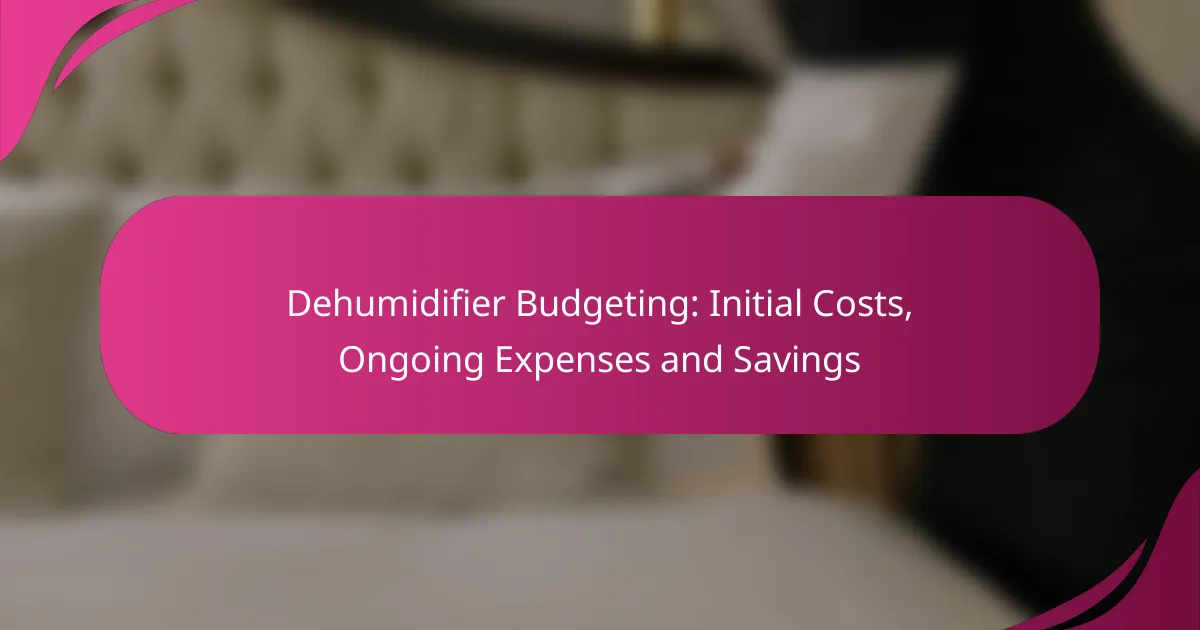When budgeting for a dehumidifier, it’s essential to account for both the initial costs and ongoing expenses. Initial prices in Canada can range from a few hundred to over a thousand dollars, depending on the model and capacity, while ongoing costs include energy use, maintenance, and repairs. Investing in a dehumidifier can ultimately lead to savings by preventing moisture-related damage and health issues, making it a valuable addition to your home.

What are the initial costs of dehumidifiers in Canada?
The initial costs of dehumidifiers in Canada typically range from a few hundred to over a thousand Canadian dollars, depending on the type and capacity. When budgeting, consider both the purchase price and any additional installation expenses that may arise.
Purchase price range for residential dehumidifiers
Residential dehumidifiers in Canada generally fall within the price range of CAD 200 to CAD 1,500. Smaller, portable units are usually on the lower end, while larger, more powerful models can reach the higher end of the spectrum. It’s essential to assess your specific needs, such as the size of the area to be dehumidified, to determine the best fit for your budget.
When shopping, look for features that may justify a higher price, such as energy efficiency, noise levels, and additional functionalities like built-in humidistats or continuous drainage options.
Installation costs for dehumidifiers
Installation costs for dehumidifiers can vary significantly based on the complexity of the setup. For portable units, installation is typically minimal, often requiring just a power outlet. However, whole-home dehumidifiers may necessitate professional installation, which can range from CAD 300 to CAD 1,000, depending on the home’s existing HVAC system and the installation’s complexity.
Before proceeding with installation, obtain quotes from multiple contractors to ensure competitive pricing and verify that they are familiar with local building codes and regulations.
Cost differences between portable and whole-home units
Portable dehumidifiers are generally less expensive upfront, with prices starting around CAD 200, making them accessible for smaller spaces. They are ideal for targeted moisture control in specific areas, such as basements or bathrooms.
Whole-home dehumidifiers, while more costly initially, typically offer better long-term value for larger spaces or entire homes. Their prices can exceed CAD 1,000, but they provide consistent humidity control throughout the house and can enhance overall air quality, potentially leading to savings on energy bills and maintenance costs over time.

What are the ongoing expenses associated with dehumidifiers?
The ongoing expenses for dehumidifiers primarily include energy consumption, maintenance, and potential repairs. Understanding these costs can help you budget effectively and ensure your dehumidifier operates efficiently over time.
Energy consumption and electricity costs
Dehumidifiers consume electricity to operate, and their energy consumption can significantly impact your utility bills. On average, a dehumidifier may use between 300 to 700 watts per hour, depending on its size and efficiency rating.
To estimate monthly electricity costs, multiply the wattage by the number of hours used and your local electricity rate. For example, if you run a 500-watt unit for 8 hours a day at a rate of $0.12 per kWh, your monthly cost would be around $28.
Maintenance and filter replacement costs
Regular maintenance is essential for keeping your dehumidifier running efficiently. This includes cleaning the water collection bucket and checking the coils for dust buildup. Additionally, many units have filters that need replacement every 3 to 6 months, costing anywhere from $10 to $30 each.
Neglecting maintenance can lead to decreased efficiency and higher energy costs, so it’s wise to set a schedule for cleaning and filter replacement to avoid these pitfalls.
Potential repair costs over time
As with any appliance, dehumidifiers may require repairs as they age. Common issues include compressor failures, fan motor malfunctions, or refrigerant leaks. Repair costs can vary widely, typically ranging from $100 to $300, depending on the issue and whether you choose a professional service.
To minimize repair expenses, consider investing in a unit with a good warranty and performing regular maintenance. This proactive approach can extend the lifespan of your dehumidifier and reduce the likelihood of costly repairs.

How can dehumidifiers lead to savings?
Dehumidifiers can lead to savings by reducing moisture levels in your home, which helps prevent damage and health issues. By controlling humidity, they minimize costs associated with mold remediation, HVAC inefficiencies, and long-term health expenses.
Reduction in mold and mildew-related expenses
Investing in a dehumidifier can significantly lower expenses related to mold and mildew. High humidity creates an ideal environment for mold growth, which can lead to costly remediation efforts that may range from hundreds to thousands of dollars. By maintaining optimal humidity levels, you can avoid these expenses and protect your property.
Regular use of a dehumidifier can also prolong the lifespan of your home’s materials, such as wood and drywall, which can deteriorate due to moisture. This preventative measure can save you money on repairs and replacements in the long run.
Impact on HVAC efficiency and costs
Dehumidifiers can enhance your HVAC system’s efficiency, leading to lower energy bills. When humidity levels are high, your air conditioning unit must work harder to cool the air, which increases energy consumption. A dehumidifier can alleviate this burden, allowing your HVAC system to operate more efficiently.
By reducing the workload on your HVAC system, you may see energy savings of 10-30% on your monthly utility bills. Additionally, maintaining lower humidity can help extend the lifespan of your HVAC equipment, reducing the need for costly repairs or replacements.
Long-term health cost savings
Using a dehumidifier can lead to significant health cost savings by reducing allergens and respiratory issues associated with high humidity. Mold, dust mites, and other allergens thrive in damp environments, which can exacerbate conditions like asthma and allergies, leading to increased medical expenses.
By keeping humidity levels in check, you can create a healthier living environment, potentially reducing the need for medications and doctor visits. This proactive approach not only improves your well-being but can also lead to substantial savings in healthcare costs over time.

What factors should be considered when budgeting for a dehumidifier?
When budgeting for a dehumidifier, consider the initial purchase price, ongoing energy costs, and potential savings from improved air quality. Understanding these factors will help you make an informed decision that balances upfront investment with long-term benefits.
Size and capacity requirements
The size and capacity of a dehumidifier are crucial for effective moisture removal. Dehumidifiers are rated by their capacity to remove moisture, typically measured in pints per day. For most residential spaces, units that can handle 30 to 70 pints per day are common, depending on the room size and humidity levels.
To determine the right capacity, assess the square footage of the area you want to dehumidify and consider the humidity level. A small room may only need a unit with a capacity of around 30 pints, while larger basements or damp areas may require units with higher capacities.
Climate considerations in Canada
In Canada, climate plays a significant role in dehumidifier budgeting. Regions with high humidity levels, especially during summer, may require more powerful units to maintain comfortable indoor air quality. In contrast, drier areas may need less robust models.
Additionally, consider seasonal variations. A dehumidifier that performs well in summer may need to be adjusted or turned off in the winter months when indoor humidity levels typically drop. This seasonal use can impact ongoing energy costs.
Brand reputation and warranty options
Choosing a reputable brand can influence both the initial cost and long-term reliability of your dehumidifier. Well-known brands often provide better customer support and more durable products, which can save you money on repairs or replacements.
Warranties are also an important consideration. Look for models with at least a one-year warranty, and consider extended warranty options for added peace of mind. A good warranty can protect your investment against potential defects or failures.

How do dehumidifier prices compare across different brands?
Dehumidifier prices vary significantly across brands, influenced by features, capacity, and energy efficiency. Generally, well-known brands like Frigidaire and Honeywell offer a range of models that cater to different budgets, while newer brands may provide competitive pricing with fewer features.
Price comparison of Frigidaire vs. Honeywell
Frigidaire dehumidifiers typically range from around $150 to $300, depending on the model and capacity. Honeywell models, on the other hand, can cost between $130 and $350, with some high-capacity units exceeding this range. Both brands offer reliable options, but Frigidaire is often noted for its energy efficiency.
When comparing specific models, consider the features such as built-in pumps, smart technology, and noise levels, as these can impact the overall value. For instance, a Frigidaire unit with a built-in pump might be priced higher but could save on installation costs.
Cost analysis of LG vs. Whirlpool models
LG dehumidifiers generally fall within the $200 to $400 range, known for their advanced technology and energy-saving features. Whirlpool models are often priced similarly, around $180 to $350, but may offer fewer smart features compared to LG.
When choosing between LG and Whirlpool, assess the warranty and customer service reputation, as these factors can affect long-term satisfaction. Additionally, look for seasonal sales which can provide significant savings on both brands.
Consumer reviews and value assessments
Consumer reviews highlight that both Frigidaire and Honeywell often receive high marks for reliability and performance, while LG is praised for its innovative features. Whirlpool tends to have mixed reviews, with some users appreciating its affordability but noting issues with noise levels.
To gauge value, consider not just the initial cost but also the long-term energy efficiency and maintenance costs. Reading user experiences can provide insights into how well a dehumidifier performs over time, helping you make a more informed choice.

What are the best practices for maximizing dehumidifier efficiency?
To maximize dehumidifier efficiency, focus on proper placement, regular maintenance, and optimal usage. These practices help ensure the unit operates effectively, reducing energy costs and improving indoor air quality.
Optimal placement and usage tips
Place the dehumidifier in a central location within the space to enhance air circulation and moisture removal. Avoid placing it near walls or furniture that may obstruct airflow. Additionally, ensure windows and doors are closed during operation to prevent outside humidity from entering.
Set the humidity level to around 30-50% for optimal performance. Using a hygrometer can help monitor humidity levels accurately. If the space is particularly damp, consider running the dehumidifier continuously until the desired humidity is achieved.
Regular maintenance routines
Regular maintenance is crucial for maintaining dehumidifier efficiency. Clean or replace the air filter every few months to ensure proper airflow and reduce strain on the unit. Additionally, check the water reservoir frequently and empty it as needed, or consider a model with a continuous drainage option.
Inspect the coils and fins for dust buildup and clean them periodically. This will help maintain optimal cooling and moisture removal. Lastly, ensure the unit is level to prevent water pooling and potential damage.
